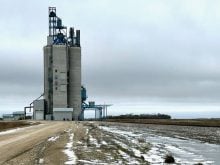Producers in some provinces have not yet drawn a cent from a federal pot of money established to help them identify and manage environmental risks on their farms.
Two years ago, the federal government committed $265 million to support environmental farm planning and help implement practices on farms that would benefit producers and the environment. The money was to be paid out over five years as part of Ottawa’s commitment under the environment section of the national agricultural policy framework.
With just over three years left in the program, a large chunk of the money is still waiting to be spent. Manitoba and Saskatchewan are among those provinces where producers have yet to see direct benefits to their farms.
Read Also

Internet of Things tapped for better emissions insights
Interconnected field sensor fleet allows better soil monitoring coverage and, hopefully, live insights on farm greenhouse gas emissions and nitrogen fertilizer application for farms.
“When you look at the first two years, we’re way under what our planned expenditure was,” said Gerry Steranko, manager of the Prairie Farm Rehabilitation Administration’s operational planning division, describing the overall spending across the country.
“We have to now look at reprofiling the money. That means moving this money forward into the next three years.”
The $265 million was designated for environmental farm planning and spending under the national farm stewardship program to pay for beneficial practices such as manure management, erosion control and wildlife habitat preservation.
Producers do not get paid for completing environmental farm plans, but they must do those plans before they can apply for money from the national farm stewardship program. Up to $30,000 is available per applicant during the lifetime of the program, which ends March 31, 2008.
Quebec is well ahead of Western Canada in implementing environmental farm plans. That effort began even before the commitment of $265 million by Ottawa.
On the other hand, farmers in Manitoba and Saskatchewan are only now getting acquainted with those plans with the help of delivery agencies recognized by government.
By the time Manitoba producers are ready to apply for money to undertake the beneficial management practices, the APF will be nearing an end, said David Rolfe, president of Keystone Agricultural Producers.
A further challenge is that producers need to pay some of the cost of implementing those practices if they want to tap the money from Ottawa. The producer share of the cost is at least 50 percent and can range as high as 70 percent.
“Given the current farm economy and the lack of resources or equity to cost share, you begin to wonder what the actual uptake will be in the short term,” Rolfe said.
“I would hope that that (federal) money would not be lost and simply go back into the big black hole of the Treasury Board.”
Each province has been allocated a specific portion of the $265 million. The share for Manitoba is $32.67 million; for Saskatchewan $39.82 million; for Alberta $48.8 million; and for British Columbia $20.28 million.
Environmental farm planning should be generally available to Saskatchewan producers this year and it’s possible that they could begin tapping money for beneficial management practices by the end of 2005, said Jack Zepp, Saskatchewan Agriculture’s director of agribusiness development. Zepp believes his province will be able to use its allocation within three years.
“Maybe I am overly optimistic, but I’m going to say I think we can do it.
“We’ve got a lot of farmers here and I don’t think it takes much to eat up the allocation.”
Neither Steranko nor Richard Escott, who leads environmental farm planning and the national farm stewardship program across Canada, could say how much money has been spent so far across the country.
The national farm stewardship program follows a fiscal year that runs from April 1 to March 31. Several provinces only indicate on a quarterly basis how much was spent under the program.














